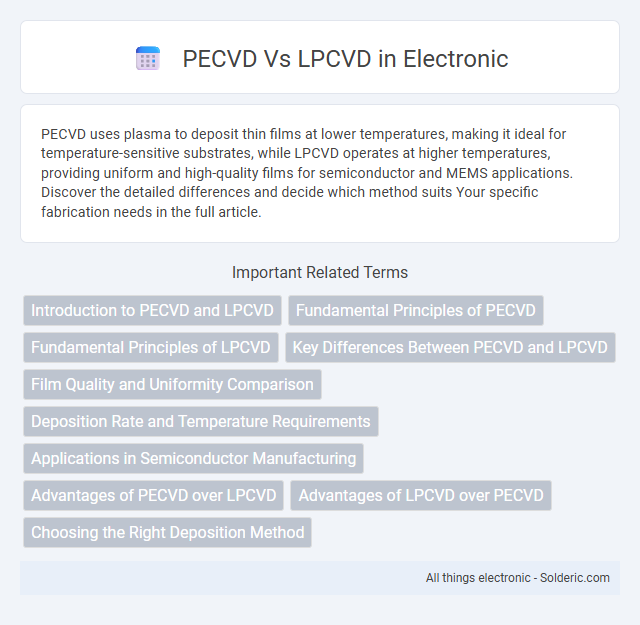PECVD uses plasma to deposit thin films at lower temperatures, making it ideal for temperature-sensitive substrates, while LPCVD operates at higher temperatures, providing uniform and high-quality films for semiconductor and MEMS applications. Discover the detailed differences and decide which method suits Your specific fabrication needs in the full article.
Comparison Table
| Feature | PECVD (Plasma Enhanced CVD) | LPCVD (Low Pressure CVD) |
|---|---|---|
| Process Temperature | Low (200-400degC) | High (600-900degC) |
| Deposition Rate | Moderate to High | Low to Moderate |
| Film Quality | Good, but may have more defects | High purity, dense, uniform films |
| Conformality | Excellent on high aspect ratio structures | Good but less conformal than PECVD |
| Applications | Temperature-sensitive substrates, dielectrics, passivation layers | High-quality oxides, nitrides for microelectronics |
| Equipment Cost | Generally lower | Generally higher |
| Gas Pressure | Near atmospheric or low pressure with plasma | Low pressure (~0.1-1 Torr) |
Introduction to PECVD and LPCVD
Plasma-Enhanced Chemical Vapor Deposition (PECVD) and Low-Pressure Chemical Vapor Deposition (LPCVD) are advanced techniques used to deposit thin films in semiconductor manufacturing and materials science. PECVD utilizes plasma to enhance chemical reactions at lower temperatures, making it ideal for temperature-sensitive substrates, while LPCVD operates at higher temperatures and reduced pressures to achieve uniform, high-quality film layers. Understanding the differences between PECVD and LPCVD helps you select the appropriate deposition method based on your material compatibility and process requirements.
Fundamental Principles of PECVD
Plasma-Enhanced Chemical Vapor Deposition (PECVD) utilizes plasma to create reactive species at lower temperatures, enabling thin film deposition on temperature-sensitive substrates. Unlike LPCVD, which relies on thermal energy to drive chemical reactions, PECVD generates ions and radicals through plasma excitation, enhancing reaction kinetics and film quality. Your choice between PECVD and LPCVD depends on material compatibility, temperature constraints, and desired film properties.
Fundamental Principles of LPCVD
LPCVD (Low-Pressure Chemical Vapor Deposition) operates by introducing gaseous precursors into a low-pressure chamber where thermal energy triggers chemical reactions, depositing thin films uniformly on wafer surfaces. This process relies on surface reaction kinetics controlled by temperature and pressure, enabling precise film thickness and composition essential for semiconductor fabrication. LPCVD offers superior conformality and step coverage compared to PECVD, making it ideal for high-quality dielectric and polysilicon layers.
Key Differences Between PECVD and LPCVD
Plasma Enhanced Chemical Vapor Deposition (PECVD) operates at lower temperatures (100-400degC) using plasma to enhance chemical reactions, while Low Pressure Chemical Vapor Deposition (LPCVD) runs at higher temperatures (500-900degC) under low pressure, relying solely on thermal energy. PECVD offers faster deposition rates and better control over film properties, making it ideal for temperature-sensitive substrates, whereas LPCVD delivers superior film uniformity and conformality suited for high-quality silicon oxide or nitride layers. Your choice between PECVD and LPCVD depends on the required film characteristics, processing temperature constraints, and throughput considerations.
Film Quality and Uniformity Comparison
PECVD delivers excellent film quality with lower deposition temperatures, enabling better compatibility with temperature-sensitive substrates, while LPCVD generally produces denser and higher-purity films due to its high-temperature process. Uniformity in PECVD is typically more challenging over large wafers because of plasma non-uniformities, whereas LPCVD offers superior thickness uniformity across the substrate through enhanced gas phase diffusion and consistent thermal conditions. The choice between PECVD and LPCVD depends on balancing film density, uniformity, substrate compatibility, and processing temperature requirements.
Deposition Rate and Temperature Requirements
PECVD offers higher deposition rates at lower temperatures, typically between 200-400degC, making it suitable for temperature-sensitive substrates. LPCVD, operating at higher temperatures ranging from 600-900degC, provides slower deposition rates but yields films with superior uniformity and conformity. Your choice depends on balancing the need for deposition speed against temperature constraints and film quality.
Applications in Semiconductor Manufacturing
PECVD (Plasma Enhanced Chemical Vapor Deposition) enables low-temperature deposition of thin films, making it ideal for temperature-sensitive semiconductor devices such as thin-film transistors and passivation layers. LPCVD (Low-Pressure Chemical Vapor Deposition) offers superior uniformity and high-quality films, commonly used for gate oxides, polysilicon layers, and dielectric films in integrated circuits. Your choice between PECVD and LPCVD depends on the required film properties, thermal budget, and specific application in semiconductor manufacturing processes.
Advantages of PECVD over LPCVD
PECVD offers lower processing temperatures, enabling deposition on temperature-sensitive substrates and expanding material compatibility. It provides superior film conformality and uniformity in complex device architectures due to its plasma-enhanced reactive species generation. PECVD's faster deposition rates enhance throughput, making it ideal for high-volume semiconductor manufacturing and advanced microelectronics applications.
Advantages of LPCVD over PECVD
LPCVD offers superior film uniformity and conformality, making it ideal for complex 3D structures and high-aspect-ratio features in semiconductor fabrication. The process operates at higher temperatures, resulting in better film quality with fewer defects and improved step coverage compared to PECVD. LPCVD also provides enhanced control over film composition and thickness, which is critical for applications requiring precise material properties.
Choosing the Right Deposition Method
Choosing the right deposition method depends on your layer thickness, uniformity, and temperature requirements; PECVD offers lower temperature processing and excellent conformity ideal for temperature-sensitive substrates. LPCVD provides superior film quality and uniformity at higher temperatures, making it suitable for applications demanding dense, high-purity films. Evaluate materials, thermal budgets, and desired film characteristics to determine whether Plasma Enhanced Chemical Vapor Deposition or Low Pressure Chemical Vapor Deposition best meets your fabrication needs.
PECVD vs LPCVD Infographic

 solderic.com
solderic.com